There are music album covers that go down in history, not only because of the music they contain. Also, their graphic design, the photos or illustrations used, their innovative approach, or sheer coincidence make them become part of the legend. Thanks to their creators, they become an inspiration and a reference point for future generations of designers working in the music industry. This was the case here.
A cliché photo of five (!) guys taken in London, which has become a symbol, and an equally plain photo of another five from Soweto, symbolizing something completely different. What do they have in common? That both photos have contributed to some of the most iconic music album cover designs.
The Beatles and the world’s most famous music album cover design
These were the last recordings together by four friends who were really fed up with each other. They promised the producer that they would do it like in the good old days. The previous recordings (released as the last album of the Beatles, Let It Be) took place in a horrible atmosphere, full of reluctance, mutual accusations, and more or less hidden spite.
The whole thing was initially to be titled Everest – in tribute to the cigarettes of that name that sound engineer Geoff Emerick smoked. Towards the end of the recordings, Paul McCartney came up with the idea of a photoshoot on a pedestrian crossing near the recording studio. He wanted another cover for the Four’s album, breaking away from the overloaded baroque pop of which Sgt. Pepper’s… was the crowning glory. Just a photo, no album title or band name. They didn’t need them. After all, a few years earlier Lennon had announced that they were more popular than Jesus.
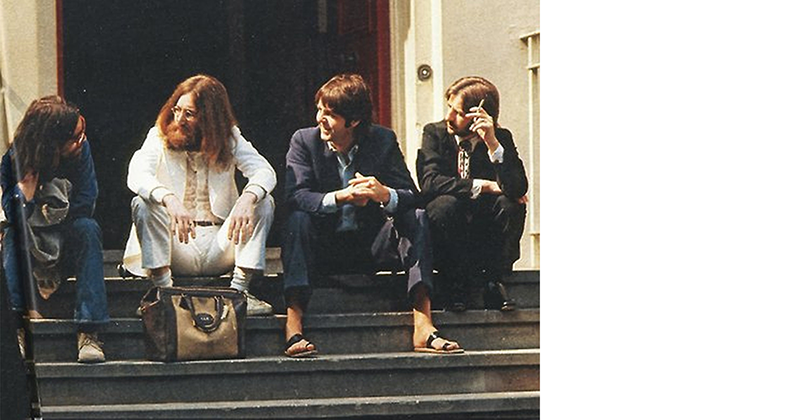
Photo shoot at Abbey Road
On 8 August 1969 at around 11am there was a slight commotion on Abbey Road. Photographer Iain Macmillan set up a ladder in the street and took six pictures from it. He placed one of them on the cover (and it went down in legend). The result of this quick and hurried session is a photo full of random elements. Creators didn’t have everything under control. The officers guarding the whole thing did not notice that there was a man standing next to a black police van (the fifth character in the photograph). He was American salesman Paul Cole, who was on holiday in London with his wife. However, he had no idea that he was staring at the most famous music band in the world. Paul (as it’s said) never listened to the full album until the end of his life, because he didn’t like the Beatles.
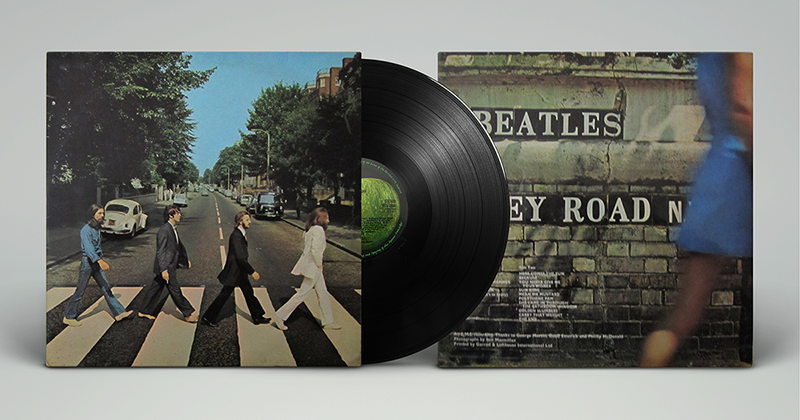
Conspiracy theory based on music album cover design
Macmillan’s photography also gave rise to one of the more bizarre conspiracy theories. OK, the QAnon and Pizzagate stories are more offbeat. But in 1969 people have no internet yet and this cover was enough to prove the thesis of… McCartney’s death. This was allegedly proved by Paul himself (or rather his double). He was walking with an uneven step, barefoot and with a cigarette in his right hand. Yet everyone knew he was left-handed! The famous music album cover design, however, supposedly contains other evidence as well. On the cover, you can see a hunchback with the registration number LMW 281F. Some read the end of the number as “28 IF”. According to them, this means that McCartney would have been 28 if he had lived (in fact, he was a year younger at the time).
Crosswalk as a symbol
It was just a fabricated theory, but the picture shows something tangible. There seems to be a symbolic transition from playing together, which began in their early teens, to the solo careers of mature men. And the first to make the transition is Lennon.
Real millionaires are crossing the zebra crosswalk in London’s St John’s Wood with a confident step. Three of them are wearing suits from Tommy Nutter, one of London’s most fashionable and expensive tailors among the stars. Only George Harrison decided for jeans and a shirt.
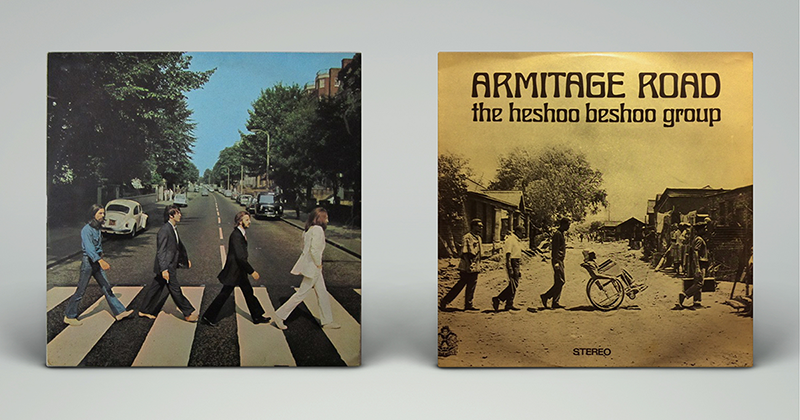
Crosswalk at Armitage Road – another famous music album cover design
Just a year later, an album cover was created, directly referencing the Fab Four’s release. It is the symbolic opposite of the British original. Can you imagine anything more contrasting? In small Orlando (part of Soweto), five musicians walk across Armitage Road. It’s a dusty, barely paved road. On either side, you can see mangled shacks covered with corrugated metal sheets that stand tightly together. The photograph is monochrome. The dirty browns only emphasize that this is a passage to a completely different world from that London summer. This is apartheid-ridden South Africa.
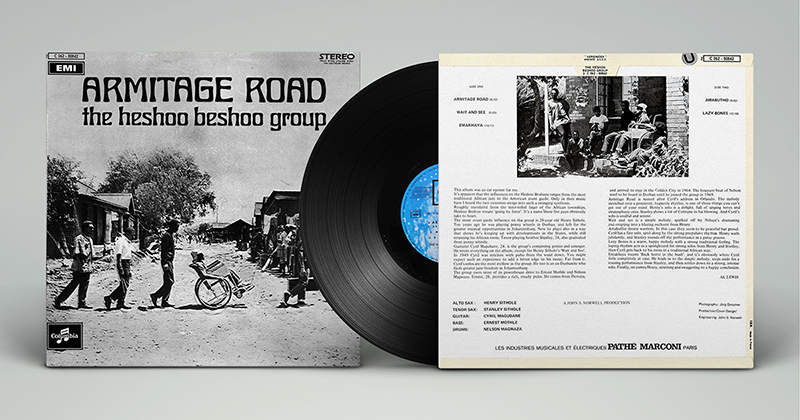
Who are the pedestrians in the photo?
The characters in this photograph cross their path with a not-so-sure step. Two of them bow their heads in contemplation. One of the musicians crosses the countryside in a wheelchair. He suffered polio as a child. Poliomyelitis (the official name for the disease) is caused by the poliovirus. It leads to atrophy and paresis of the lower limbs. With the invention of the vaccine, it was possible to end the polio epidemic in the northern hemisphere in the 1960s. Developing (and poor) countries were struggling with the disease for much longer. South Africa’s black community did not have the chance to be vaccinated quickly, and in Africa, wild strains of polio were not eradicated until 2020!
These shy musicians are the Heshoo Beshoo Group (although “heshoo beshoo” supposedly means “walk boldly”), jazzmen from Soweto. The band was founded by saxophonist Henry Sithole. The other members were his brother Stanley Sithole, who played tenor saxophone, guitarist Cyril Magubane (who lived on Armitage Road) and bassist Ernest Mothle and drummer Nelson Magwaza. Their music, temperamental and lively jazz, seems the best break from the reality depicted on the cover.
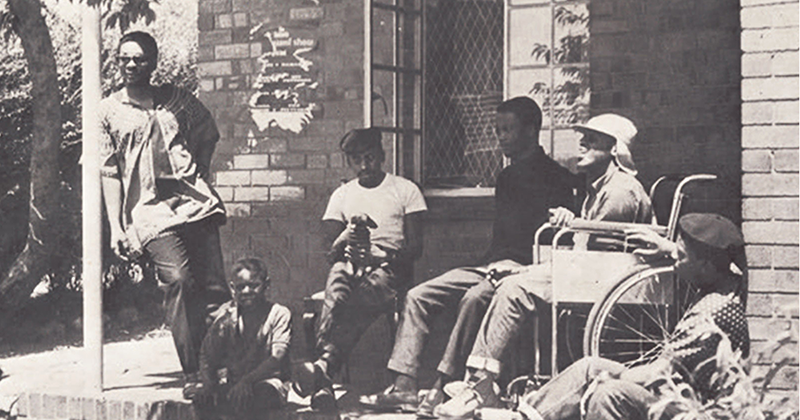
How was the album produced?
The young jazz enthusiast John Norwell is responsible for the conception of the whole album, as well as for the cover design. Jörg Genzmer, in turn, took the photograph. The recording of this album at this time, by these musicians, and in this place in the world seems even less likely than the participation of McCartney’s double in the London session at Abbey Road. This was probably only possible thanks to Norwell, whose father sat on the board of the South African branch of the EMI label. And the record was eventually released by the Little Giant label (a sublabel owned by the giant). This release is basically unobtainable and has become a white whale for collectors around the world. Fortunately, late last year We Are Busy Bodies (a small, independent label from Canada) re-released this album on vinyl. The first 1500 copies sold out in no time.
Found this article interesting? I encourage you to read the others in this series: Banana Cover Album and Run the Jewels album covers. If you are looking for more inspiration make sure to check out and download our culture book.
Source: bandcamp.com, discogs.com, thevinylfactory.com.

